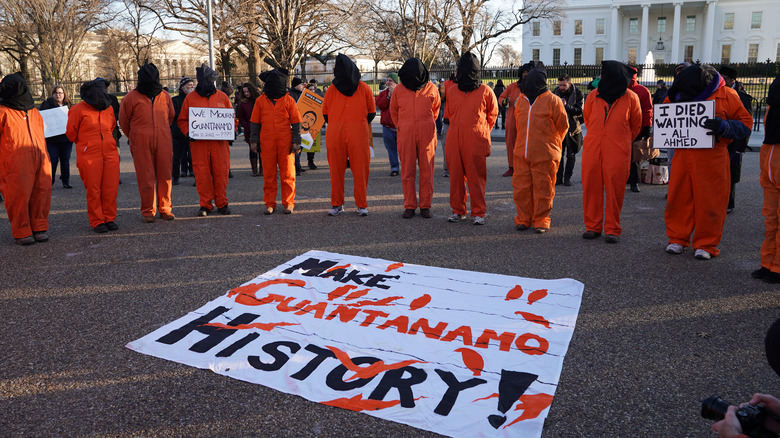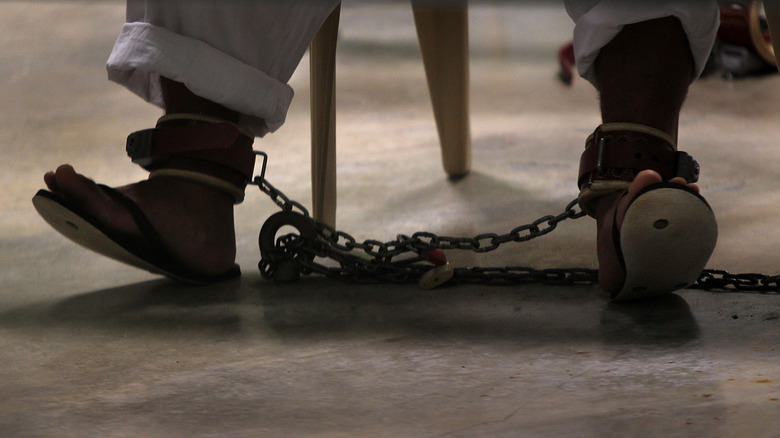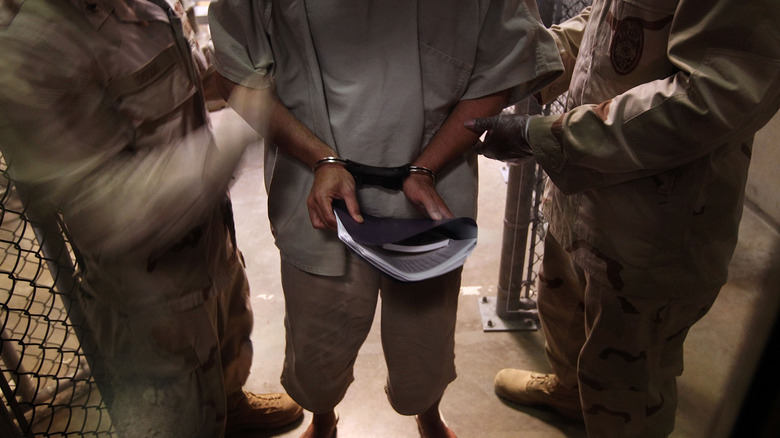Inside The CIA's Horrific Sleep Deprivation Chambers
If you've ever been to a torture device museum, it's likely that you wondered who could come up with so many ways to cause agony. In medieval Europe, myriad contraptions were conjured and constructed to not only torture whoever was deemed deserving, but also as a warning to those who witnessed that unfortunate person endure ongoing torment. The knowledge that the same fate may befall someone if they did not behave accordingly sent a powerful message.
Fast-forward to the United States in the early aughts. By now, torture was done secretly so that there would be less outcry from the public — less interfering by groups like Amnesty International or Human Rights Watch. It would also become more of a psychological effort. Reportedly, the Central Intelligence Agency subjected purported Islamic terrorists and suspects in the 9/11 attacks on the United States to various methods of state sanctified interrogation tactics at the U.S. Navy base in Cuba, Guantanamo Bay, and at other places around the world called "black sites."
The reason for the psychological torture was a means to get the detainees to tell the CIA what they knew. According to an agency document called Counterterrorism Detention and Interrogation Activities (Sept. 2001-October 2003), the CIA hired two independent psychologists to look into how to develop countermeasures to al-Qaida's "resistance to interrogation techniques."
The psychologists came up with new and improved means of psychological persecution. They called the methods "Enhanced Interrogation Techniques."
The CIA claimed Enhanced Interrogation Techniques did not meet the definition of torture
Enhanced Interrogation Techniques were designed to inflict enough discomfort and pain to make a person act at the CIA's will, but not kill or cause permanent harm. It included things like being made to stay in "stress positions," waterboarding, being put in cramped confinement— sometimes with insects— slaps in the face, and sleep deprivation. It was declared that the methods used in the Enhanced Interrogation Techniques did not violate the rules against torture prohibition in the U.S., per the CIA's Counterterrorism Detention and Interrogation Activities report.
According to that report, sleep deprivation should not exceed 11 days at a time, but then there were other caveats. Human Rights First explained that CIA guidelines deemed sleep deprivation of up to 180 hours as acceptable, with more than 72 hours of sleep deprivation being part of the "enhanced" tactics and sleep deprivation of less than 72 hours being the protocol for "standard" techniques. In 2003 that number changed to over or under 48 hours, per the CIA's orders.
There were various ways detainees were kept from sleeping, and those generally incorporated other interrogation "techniques." They would be forced to stand for hours on end, or be shackled with their arms above their heads, or in another stress position. Sometimes they were stripped naked. Guantanamo Bay prisoner Abu Zubaydah said he was shackled flat on the ground in a painful position, so that sleep was impossible, according to The New York Times.
The CIA and psychologists said depriving people of sleep within limits wouldn't kill them
According to the CIA and psychologists who came up with the enhanced techniques, prohibiting sleep was not harmful long term. "Sleep deprivation ... clearly does not involve a threat of imminent death. Although it produces physical discomfort, it cannot be said to constitute a threat of severe physical pain or suffering from the perspective of a reasonable person," per the CIA report.
They go on to say that as long as sleep deprivation is used in "limited periods, before hallucinations or other profound disruptions of the senses occur," any negative consequences caused by long periods with no sleep would all be rectified once a person is allowed to sleep again.
The way it was often handled was that detainees were kept awake and in uncomfortable positions for long stretches of time with occasional position changes and a couple of hours of sleep allowed between. Reportedly, one man was made to stand for 70 hours without sleep, then permitted four hours of sleep. After which, he endured another 23 hours of standing sleep deprivation, followed by 20 more hours in a seated position without sleep, according to Human Rights First.
When men complained or voiced concern for their well-being due to lack of sleep, they were told that what they were feeling was normal for having not slept in so long, and it would all stop once the tormented person simply told the truth.


